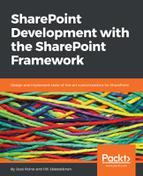Book Description
Design and create beautiful solutions using modern development tools for SharePoint Online
About This Book
- Get the best out of the latest Sharepoint Framework and leverage the Sharepoint RESTful and JSOM APIs.
- Develop efficient client side applications with JavaScript injection and Sharepoint Addins.
- Get the best tips and tricks on designing your website flawlessly.
Who This Book Is For
This book targets current SharePoint developers, as well as people starting their journey on SharePoint development. The reader must have basic web development programming knowledge, including JavaScript and CSS. The reader should have familiarity using and managing SharePoint-based collaboration sites.
What You Will Learn
- Understand what the SharePoint Framework is
- Create modern solutions using the new tools, approaches and frameworks
- Learn how to use Visual Studio Code for effective SharePoint development
- Package and deploy your code, using automation as needed
- Work with content and data stored in SharePoint
- Benefit from third party frameworks without having to build your own frameworks
- Debug and troubleshoot your code with ease
- Configure security in your application
In Detail
SharePoint is one of Microsoft's best known web platforms. A loyal audience of developers, IT Pros and power users use it to build line of business solutions.
The SharePoint Framework (SPFx) is a great new option for developing SharePoint solutions. Many developers are creating full-trust based solutions or add-in solutions, while also figuring out where and how SPFx fits in the big picture.
This book shows you how design, build, deploy and manage SPFx based solutions for SharePoint Online and SharePoint 2016.
The book starts by getting you familiar with the basic capabilities of SPFx. After that, we will walk through the tool-chain on how to best create production-ready solutions that can be easily deployed manually or fully automated throughout your target Office 365 tenants.
We describe how to configure and use Visual Studio Code, the de facto development environment for SPFx-based solutions. Next, we provide guidance and a solid approach to packaging and deploying your code.
We also present a straightforward approach to troubleshooting and debugging your code an environment where business applications run on the client side instead of the server side.
Style and approach
The approach will be that of a practical tutorial which will take you through every topic using code samples and working examples.
Downloading the example code for this book. You can download the example code files for all Packt books you have purchased from your account at http://www.PacktPub.com. If you purchased this book elsewhere, you can visit http://www.PacktPub.com/support and register to have the code file.
